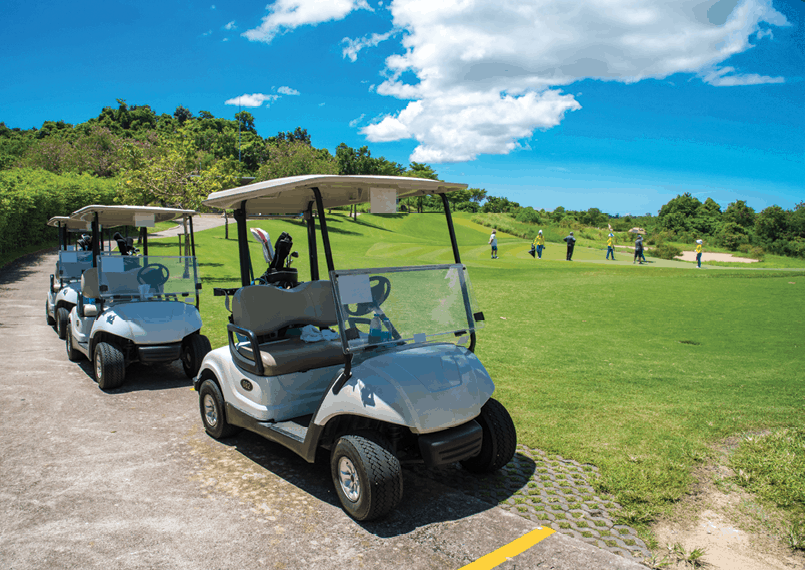
Golf carts are a crucial element in virtually any golf operation. In the wake of the COVID-19 pandemic, golf facilities are facing new and unique challenges as they work to balance health and safety concerns with player comfort and convenience and their own bottom line.
Wes Forester is the director of golf at Reynolds Lake Oconee in Greensboro, Georgia, 85 miles east of Atlanta. The 12,000-acre site features six 18-hole golf courses.
A new era dawned March 18 when COVID-19-related restrictions kicked in, forcing Forester to consolidate the facility’s resources.
“The decision was made to go from six golf courses to four at that point,” he says. “We took the golf carts from the two locations that were closing and moved them all to the other locations.”
Every available cart was needed. In fact, additional carts were brought in to accommodate a single-rider policy. “Every able-bodied adult needed to take an individual golf cart whether or not they were in the same household,” Forester says. “That creates some challenges. We have electric carts. We could only charge so many at a time, even though we might have had more. I think we had 103 to 105 at each location. You might have 76 to 80 charged in the morning, but we had to get the rest ready and charged.
“We knew we only had so many tee times available for the amount of players in the morning so we could have enough for the afternoon. We had to limit the tee times we had available each day.”
Tee times were available until 3 p.m., with nine-hole rounds available until 5 p.m. Over time, partners and family members living in the same household were permitted to share a cart.
Eventually, each course was hosting about 150 players each day. That number included a fair number of walkers. Before the pandemic, less than 1 percent of the rounds at Reynolds Lake Oconee were walking rounds. But that circumstance changed and in due time some 30 to 50 golfers were walking each day.
“As we had limited tee times, we had members that would ask, ‘If I walk, can I go play?’ Forester says. “Sure, absolutely, especially later in the day. And we’ve been very lucky in Georgia. The temperatures have been extremely cool until recently.”
To accommodate the additional walkers, the club opened one of its courses 10 days ahead of schedule for walking only and rented additional pushcarts.
Mark Bryson is the director of golf at Jumping Brook Golf Club, a private club in Neptune, New Jersey, about an hour south of New York City. On a typical day, the club will have 64 electric carts available for members. Bryson will bring in additional carts when circumstances warrant — for a large outing, for instance. When golf courses in New Jersey reopened May 2 after being closed six weeks because of COVID-19, he had a plan in place.
“We rented an additional 24 carts prior to the reopening,” he says. “So, we currently have 88 carts in play. And we’ve been able to manage. We purchased a steam-powered power washer. It was sort of ironic, it had nothing to do with the pandemic. It was something that was available to us in a purchase and we decided it would be a good thing to have on property for a couple different reasons, but now it’s turned into a great operational tool for us to properly clean carts.”
A lot of carts needed to be cleaned. The executive order that permitted golf courses to reopen in New Jersey stipulated one rider per cart. That created what Bryson described as “an operational challenge.”
“We’re flipping golf carts immediately as they come off of 18,” he says. “People are putting their clubs in their cars and bringing the cart back and we’re taking the golf cart and power washing it and turning it back into line. In a lot of cases, some players are teeing off as we’re bringing a new, clean cart to them at the first tee. It has been an operational challenge, but it’s a great problem to have. That means we’re an outlet during this crazy time for people to play some golf.” (The mandate for single-rider golf carts was lifted on June 10, but a club must provide a single-rider cart upon request).
COVID-19 became an issue in Arizona at the height of the golf season, when visitors were flocking to the area for MLB spring training and to escape the winter cold. Brady Wilson is the general manager at Ak-Chin Southern Dunes, a daily-fee club in Maricopa, Arizona, outside Phoenix.
When the pandemic hit, Wilson, who is a PGA professional, adjusted his cart policies. “We didn’t pair groups anymore,” he says. “If you were a twosome and there was a twosome right behind you, normally, we would pair those twosomes up and make it a foursome. We didn’t pair anybody up. We left you in the group that you booked with. … We didn’t put anybody additional with you. We let you go with your group.”
Golfers were encouraged to take separate carts, although they were not required to do so.
“We encouraged everyone to take their own golf cart,” Wilson says. “We would allow that by exception” — spouses who requested to share a cart, for instance — “but in general, we went solo. If we had a foursome of four guys, they would take four carts.”
Deerpath Golf Course in Lake Forest, Illinois, just outside Chicago, is a municipal facility, which, like all golf courses in Illinois, was shut down in mid-March. When the club was allowed to reopen May 1, golf carts were largely prohibited. Play was limited to twosomes and tee times were spaced 15 minutes apart. (Golfers with a handicap placard or with a doctor’s authorization were permitted to ride.)
On May 29, restrictions were eased statewide. Foursomes are now permitted, with tee times spaced 10 minutes apart. Single-rider carts are the norm, though members of the same household can ride together.
Vince Juarez, Deerpath’s general manager, realized early on that the fleet of 60 carts would not be enough for the expected — and realized — surge in play and put together an action plan. “We partnered with Rolling R, a rental-cart fleet company and brought in 15 additional golf carts to add to our fleet,” he says. “Even before (Illinois Governor J.B. Pritzker) had announced single-rider carts, we were in talks to confirm and solidify the extra carts knowing carts would be at a premium once the state made their decision to go to individual riders.”
Juarez’s decision proved prophetic as clubs found extra carts difficult, if not impossible, to obtain.

Economic impact
The effect of the COVID-19 pandemic on overall bottom lines and cart revenue varies according to individual circumstances.Ak-Chin Southern Dunes has 82 carts. The fact that so many players were riding solo tested the limits of the tee sheet and impacted the club’s bottom line.
“On a full day, normally I could do 240 to 250 rounds,” Wilson says. “I was not capable of doing that because I had so many carts going out as solo riders that I didn’t have enough available for people to come back around. So, there were spacing blocks. We spaced our tee times out a little further. We blocked a tee time every hour and a half.”
At Ak-Chin Southern Dunes, a golf cart or pushcart is included in the greens fee. In practical terms, however, single-rider carts and a longer interval between tee times has an impact. “You’re still putting the entire fleet out,” Wilson says, “so that’s still a lot of work for your team and then the disinfecting and sanitation of a cart take a lot longer” — five or six minutes per cart. “You’re asking your staff to work harder for less rounds of golf.”
At Reynolds Lake Oconee, Forester saw rounds increase this spring as more of the community’s 2,400 member/residents migrated there from areas that were severely impacted by the pandemic.
“In May, we saw our member rounds increase by almost 55 percent from what we would see in a normal May,” he says. “Even though we had those 30 to 50 walkers per day, and even though we rented 72 additional golf carts, we actually saw our revenue in golf carts go up. Basically, the rented carts got paid for and we kept our revenue up. It was amazing to see so many more member rounds and how many more were staying in their homes down here.”
At Deerpath, Juarez is still awaiting permission to reinstitute his regular tee sheet, with start times set eight minutes apart.
Is walking making a comeback?
In the wake of the pandemic, facilities may find themselves creating new ways to manage their cart fleets. Jan Bel Jan, the President of the American Society of Golf Course Architects, believes that carts and protocol may have a different look in the days ahead.
“Some may remain the two-seater carts, the traditional type,” she says. “Some may become a single-rider with the ability to carry four bags, and one person drives and everybody else (walks). Some may end up having caddies that drive the cart. They don’t touch the bags, but they drive back and forth and everybody walks.
“There may be people who choose to have some of the newer style-golf boards, bike-type situations, they’re definitely single-rider. The single-rider carts have been out quite a long time for people with disabilities.”
And then there’s the oldest form of on-course transportation. Some golfers resorted to walking this spring because carts were prohibited or unavailable. Will those who discovered or rediscovered the joys of walking stick to it?
“It will be interesting to see,” Forester says. “I think you’ll start to find more of our members will walk as long as the temperature is right. I think once we get into the summer and get into a little more of the humidity and heat, I think they’ll automatically gravitate toward golf carts. But I think in your springs and your falls, I think you will see it.”
Juarez says golfers are creatures of habit. He estimates around 20 percent of rounds at Deerpath are walking rounds. He doesn’t expect that number to increase much.
“Once we hit (May 29), I would say golfers returned to their normal habits,” he says. “If they rented a cart prior (to the pandemic), they’re renting a cart now. If they walked prior, they’re still walking.”
Forester says he’s had a lot of positive interaction with golfers who have chosen to walk.
“I can’t count how many members who have stated, ‘Wow, I forgot how much fun it is to walk,’” he says. “And it’s a better pace overall. You can walk in four or four-and-a-half hours, you’re always moving, and you get into a rhythm. You can keep a safe distance from somebody else and have a great conversation going on the golf course.”

Explore the July 2020 Issue
Check out more from this issue and find your next story to read.
Latest from Golf Course Industry
- Audubon International announces newest leadership appointees
- Southern golf trifecta
- Sports for Nature Framework gains new signatories
- Camiral Golf & Wellness upgrades Stadium Course
- Troon selected to manage The University Club of Milwaukee
- Kafka Granite adds new business development manager
- GCSAA celebrates 10-year anniversary of collaboration with Congress
- DLF launches new seed enhancement solution





